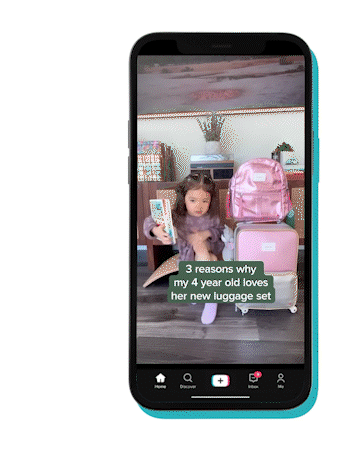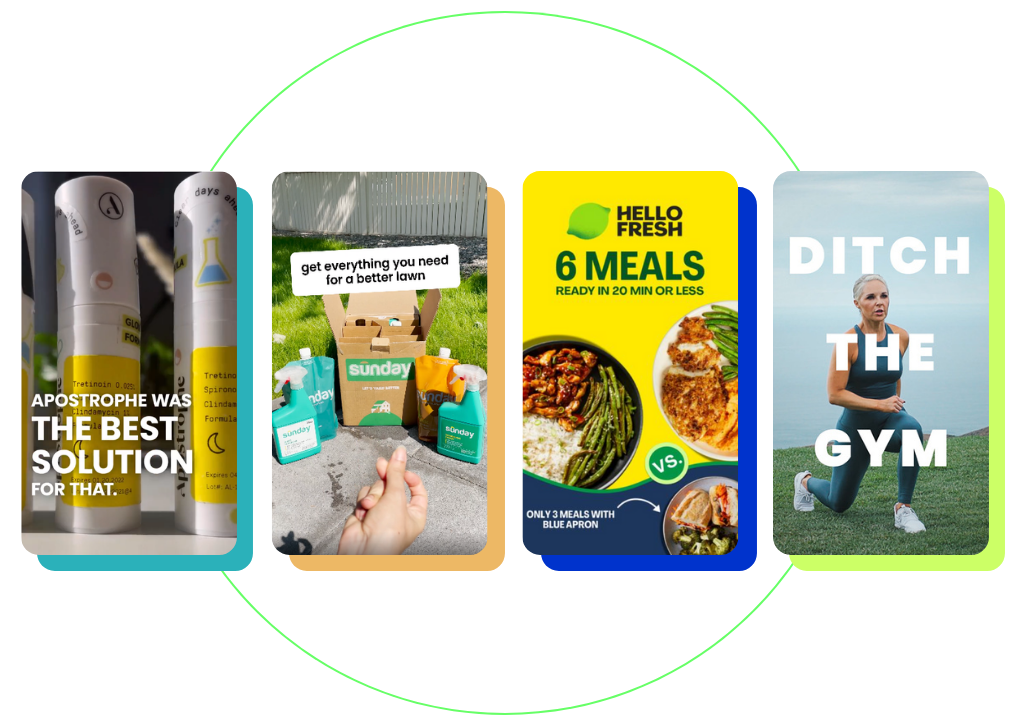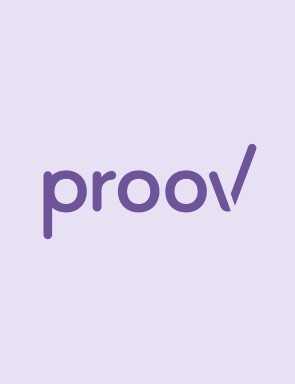In this article
Video Ads
The Key to Growth-Driven Social Media Advertising
For growth marketing professionals, video ads continue to dominate the paid social space as the most effective ad format to drive conversions.
The evolution of platforms like TikTok and Instagram has led to a video-first environment for social media. Users continue to flock to these channels, while video ads continue to be a major focus for these popular platforms.
- Statistics show that Facebook will represent 30% of global online video ad revenue by 2024.
- Facebook data shows how Facebook and Instagram video advertising continues to evolve: “Adding a Facebook In-Stream campaign to a Feed & Stories buy led to a median 1.5x increase in ad recall and a median 20% decrease in cost per incremental recaller.”
- One study projects that by 2027, TikTok will account for 37% of the roughly $331 billion in online video advertising revenue.

What does this mean for your company’s ad strategy?
As users consume more and more video, brands stay relevant through short-form video ads that leverage the native style of the platform and perform better than static image ads.
Video ads are simply a more effective vehicle to tell your brand’s story, communicate benefits, and demonstrate how your product or service works.
As recently as 2021, we saw video ads take center stage in paid social advertising, consistently outperforming static image ads.
- In 2022, video ad spending in the U.S. was predicted to grow by 20.1% year over year to $24.35 billion, accounting for more than one-third of total US social network ad spending.
TikTok is the leader in this space. Ads that perform well on TikTok are more likely to perform well on other platforms too. However, that is not always the case for the reverse. For instance, Primer’s research found that more brand-forward ads made for Instagram don’t work well on TikTok.
Take our long-time partner, Rocksbox.
When we investigated why Rocksbox’s Instagram ads didn’t perform well on TikTok, we found that the mix of polished, branded, and user-generated content (UGC) styles that work on Instagram don’t translate to the native style of TikTok.
By avoiding non-native elements like brand cards and adopting the native UGC style of TikTok—first-person voiceovers, a single-user storyline, and native media elements like music and captions—Primer helped Rocksbox increase their conversion rate by 614%.
No matter how you slice it, video ads are the clear path forward for hypergrowth marketers seeking to increase conversions and grow their brand in social media spaces like TikTok, Instagram, and Facebook.
Primer has tested thousands of video ads across the most popular paid social channels.
We can help you develop top-performing video ads that are proven to convert, regardless of the platform where you post your ad.
Here’s how to build the most effective video ads possible, so your brand can outperform its competitors and maximize conversions.
Our Guide to Video Ads
- Best Practices of a Video Ad
- Video Ad Strategy
- Video Ad Performance
- Get a Partner Who Gets Growth

Best Practices of a Video Ad
At Primer, we have cultivated a set of best practices for video ads that work time and time again.
Primer offers best-practice guidelines for our partners' ad campaigns that we developed through rigorous creative testing for top brands in the D2c space.
For example, consider YouTube’s ABCDs of effective video ads for their platform, which stands for “Attention, Branding, Connection, Direction.”
Attention (grabbing the audience’s attention), Connection (helping people think or feel something), and Direction (asking them to take action) are effective metrics for a successful video ad on or off of YouTube.
However, Primer’s research shows Branding to be a bit of a sticking point for audiences on platforms other than YouTube.
For platforms like Instagram and TikTok, heavy-handed branding can cause an ad to fall flat.
The modern social media user is quick to notice paid ads and even quicker to scroll on.
Mentioning the brand too much sets off a user’s BS detector when they spot an ad that isn’t native to the platform, which translates to fewer conversions.
Instead, focus on these elements to build a successful video ad:
Video Ad Size Ratio

While nearly all video ads are vertical rather than horizontal content, different platforms and uses require different aspect ratios for your video ads.
Here’s a brief rundown of the correct sizes for each platform:
- Facebook/Instagram In-Feed: 4:5 or 1:1
- Instagram Stories/Reels: 9:16
- TikTok: 9:16
- YouTube: 16:9 or 1:1
- Snapchat: 9:16
- Pinterest: 1:1, 9:16 or 16:9 (max width)
Size is an important factor when deciding a platform for your ad, along with the length of your video and integration of native platform elements (more on these below).
Creative
Creative is more important than ever. Good creative focuses on the customer and how a product benefits them, not on the brand and product features.
Did you know that the most effective way to find new winning ads is to test ad creative in bulk?
You can effectively test, identify, and scale winning ads to meet your goals using Primer’s Outlier Method for Creative Testing.
Here’s how to make sure you’re producing enough ad creative:
- Determine how much ad creative you need. At Primer, we recommend a minimum of 50 ad tests per every $25,000 in ad spending to ensure you’re launching enough new ads to convert consistently.
- Create your testing roadmap. At Primer we launch new tests every two weeks, alternating between a “big idea” (something that’s never been tried before) and an iteration on a previous winning ad. This cadence helps keep your account fresh with new ad creative to test. Plan your tests out two months in advance. This is your testing roadmap.
- Write creative briefs. Dedicating time to developing, reviewing, and revising creative briefs will set you up to have the most effective structure for your ads possible. Essentially, creative briefs help your team align and rapidly produce new creative around defined parameters. Instead of using one creative brief template for every ad, you should create a few different brief templates that reflect the various formats an ad could take. Some key elements to include in your brief are the type of deliverable and its intent (“the ask”), audience, parameters, conversion strategy, message and benefit, and the brand and its voice.
- “Big idea” briefs help you test a new concept, theme, audience, value proposition, product, or benefit for ad campaigns. An “iteration brief” takes a winning ad from the big idea ad set and creates several variations on that ad, changing only one or two elements at a time such as a CTA, headline, or design element
- You don’t have to start from scratch. Use our creative brief templates that are proven to convert.
- Use the creative faucet method to get started on the process.
- Streamline the design and review process. Communicate your brand dos and don’ts with your designer. When you choose Primer as your ad development and testing partner, our design professionals take time to understand your brand and provide specialized support based on the kind of creative you need.
- Repeat the process. To keep your creative pipeline full, it’s important to repeat this process on a consistent, monthly schedule.
An Attention-Grabbing Hook
Hooking a user in the first 3 seconds of your video ad is critical. That’s about how long you have before someone decides whether to engage with your video or scroll on.
Consider the “Attention” rule from YouTube’s ABCDs. It’s all about how well you’re able to immerse users in the story your ad is telling from the very first second.
Audiences for different social media platforms will usually make a judgement call on your video ad–and decide either to stick around or move on in that time.
- Facebook reports the average watch time is 10 seconds for videos on their platform.
- A TikTok study found that the average watch time was 3.33 seconds per video view and 5.26 seconds per person.
- Instagram videos that receive the most comments average about 26 seconds, according to Hubspot.
Length
According to Facebook, video ads that perform best with their users are about 15 seconds long. However, keep in mind that the highest-converting length for a video ad differs depending on the platform you’re using.
For instance, the Primer team found that TikTok videos perform best with a runtime of 21-34 seconds These longer videos have a 280% lift and result in better engagement and more time to tell a story. In fact, video ads on TikTok that are under 10 seconds could even impair delivery.
While video ads with a compelling story can run longer than this, we have found that the best-performing video ads across platforms are typically under 30 seconds
Audio
Paid social advertising was once considered an “audio off” space, where sound was considered intrusive and disruptive. Recent trends have flipped that on its head.
In the current marketing landscape, if your video ad doesn’t have audio, it won’t command the attention of your audience.
A winning video ad includes music, voiceover, and text on the screen to connect with the audience.
Primer recommends running different iterations of your ads by comparing trends like a robotic voiceover or filtered voice with a natural, human voice.

A Strong Call to Action (CTA)
Ensure your audience has some clear action to take at the end of the ad.
On platforms like TikTok, the CTA will likely be subtle and blend in with the native style of the platform. Regardless of the social channel where you place your ad, a CTA should feel organic to the platform and tell the audience what to do next.
The most effective CTAs connect the user to a landing page tailored to the user’s ad experience.
Here are a few examples of CTAs Primer has developed that are proven to convert:
Native style
These incorporate the elements used on a specific platform, like text and colors, trending sounds and music, and a video format consistent with other users who post on the platform.
An example would be ending your video ad by showing a user searching Google for a solution to their problem and ending with a CTA that is your search term.
UGC style
This could include a voiceover from a user or on-screen text, mimicking a “user-generated content” style that feels organic to the platform.
For example, end your video ad with a voiceover of a user saying, “Don’t waste any more time. Give it a try.”
Product-focused
This style of CTA drives home a product-focused message for your audience, such as, “Discover [product] just for you.”
Want more examples of CTAs proven to convert? Check out these 25 CTA ad templates we developed just for you.
A Proven Video
Ad Template
A successful 3-second hook will catch the audience’s attention, and a CTA will drive conversions, but the best way to get from that hook to conversion effectively is to use a proven video ad template.
Your video ad should follow a clear ad template that breaks down your video frame by frame using a format that has been thoroughly tested and proven to drive conversions.
Using these templates, you can test different ad sets and scale and iterate your highest-performing ads to maximize growth.
Primer tested and developed these proven video ad templates so you don’t have to:
The “How It Works” Ad Theme
The How It Works theme helps you create a video ad script that walks a user through how your product works, from problem to solution, step by step.
This ad can then be linked to a How It Works landing page, which will continue the ad experience for the user by further breaking down the steps from problem to solution and driving the user to convert.
UGC Ad Templates
User-generated content (UGC) uses content created by an individual user from a first-person point of view to share information or tell a story.
Performance-focused UGC-style ads feel organic and employ native elements of the social platform where the ad is placed.
You can hire a UCG creator to represent your brand and share their unique perspective on your product.
The “Made Easy” Template
The goal of a “Made Easy” themed video ad is to illustrate how your product is the easiest possible solution to a customer’s problem.
It shows viewers how the experience or outcome they’re seeking doesn’t have to be difficult. Others are already benefiting from trying something new, and the viewer can too.
This theme highlights how the process works in short, simple steps, reinforced with testimonials focused on ease of use.
Once you understand the main elements and best practices for creating a top-performing video ad, it’s time to build your video ad strategy.
Video Ad Strategy
Creating successful video ads requires strategy and great creative.
When it comes to strategy, testing is critical. If you aren’t testing, you aren’t optimizing your ad and the strategy surrounding it for your audience.
At Primer, we achieve this using our unique “Outlier Method,” a proven strategy for high-volume ad testing in order to rapidly identify high-performing video ads, scale and iterate more ads to boost.
Creating your video ads in ways that are modular can allow you to test multiple options with less lift instead of creating brand-new ads.
Using the Outlier Method, you can test and optimize every element of your ads, including copy, creative, landing pages, and audiences.
First, you launch a new big idea ad set – including 3-10 visuals combined with different copy, headline, and landing page combinations, for a total of 50 ads per $25,000 in ad spend).
Pause underperforming ads with higher CPAs than average – pause 50% within 48 hours of launching an ad set and 75% within 72 hours.
Scale “Outliers” by adding budget and making iterations – remaining video ads that perform 2-3x better than the rest in their campaign are your “Outliers.” They should have better performance than your account average by at least 10%. Add budget to these ads. Once you have 1 to 4 ads that either beat the previous period’s average CPA or beat your goal CPA, pause the rest.
Iterate new video ads based on your “Outliers” – repeat the process and use your best-performing iterations and to iterate even more winning video ads. Complete this process over a two week period, and repeat twice per month if budget allows.
You can use this strategy to guide your audience’s journey and target them at different stages of the sales funnel.
For example, consider the experience of Proov, a fertility diagnostics provider.
Proov learned through ad testing that they could use different video ads to tell a story to the customer over time.
First, their audience is given an ad that introduces the product as a solution, then they are retargeted to see a “how it works” focused ad, then retargeted again with a founder video.
With each stage, the target customer is pulled deeper into the brand’s story.
Video Ad Performance
The main goal of performance marketing is always to drive conversions. That means the conversion metric should always be your number one deciding factor in how to best optimize your ad campaigns.
However, other metrics can give you a more granular perspective into your ad’s performance to help identify areas to test or scale.
When you’re analyzing video ad creative, it can be helpful to understand where users stopped watching to see what got their attention, or didn’t.
Here are several metrics you can use to measure your video ad’s performance.
Three-second plays
This lets you know how many times your video ad was played for at least 3 seconds, not including replays.
This helps you understand which intro hooks are working across the many ad variations you're testing. Divide this by the total impressions to determine your thumb-stop rate.
Thru-plays
This metric measures the total number of times your video ad was played all the way through or for a minimum of 15 seconds. This doesn’t include replays. Again, divide this by total impressions to get the thru-play retention rate.
Thru-plays let you know whether you’re keeping users’ attention and getting people to watch till the end of a video ad. If not, it’s important to pinpoint where users are dropping off (see video plays below).
Video plays at various percentages
You can measure impressions of how many times your video ad starts to play, as well as the number of times your video was played at different percentages of its length.
For instance, you might compare how many times the ad was played to 25% completion, 50% completion, and 75% completion.
This lets you know where users drop off so you can understand which parts of your video ad to revise.
Get a Partner Who Gets Growth
Building sustainable growth for your organization requires high-volume ad testing, so you can identify winning ads, target what works, and use those elements to generate a steady stream of top-performing ads for maximum conversions.
Ad testing at scale requires a reliable set of processes, organizational buy-in, and a substantial volume of ad creative. At Primer, we run thousands of ad tests each month, which has allowed us to perfect the elements of the growth-driven video ad.
We understand what grabs users’ attention in the paid-social landscape, keeps it until the end of the video, and drives them to convert.
Generating the ad volume you need to effectively test and optimize growth can take time and resources that may be more effectively applied elsewhere in your organization. That’s where Primer comes in.
We’re here to help you fill the creative pipeline and position ad testing as a viable strategy within your organization. We’d love to work with you to unlock hypergrowth, and we can partner with you in whatever way best suits your needs.
Agency partner // We’ll handle the creative strategy, design, production, reporting, and media buying. You can just sit back and watch the wins roll in. Book a consultation >>
On-Demand // Get ads that convert in as little as 2 to 4 business days through our On-Demand platform.
Schedule a demo >>
Execution is the hardest part of growth marketing. At Primer, we’re here to help you build video ads that convert.


.jpg)
.jpg)
.jpg)
.jpg)
.jpg)
.jpg)
.jpg)



